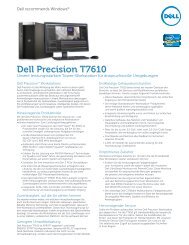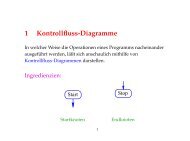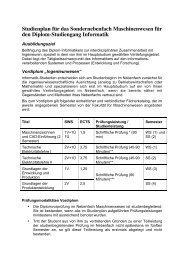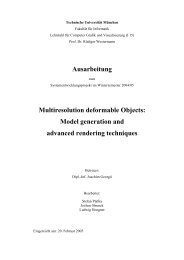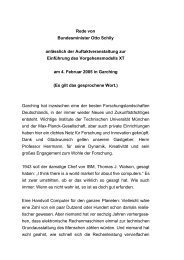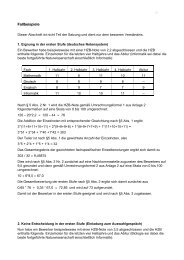A Generic and Scalable Pipeline for GPU Tetrahedral Grid ... - TUM
A Generic and Scalable Pipeline for GPU Tetrahedral Grid ... - TUM
A Generic and Scalable Pipeline for GPU Tetrahedral Grid ... - TUM
Create successful ePaper yourself
Turn your PDF publications into a flip-book with our unique Google optimized e-Paper software.
proach has some important properties: First, barycentric<br />
coordinates of sample points can directly be used to interpolate<br />
the scalar values given at grid vertices. Second,<br />
barycentric coordinates can efficiently be used to determine<br />
whether a point lies inside or outside an element. Third, by<br />
trans<strong>for</strong>ming both the point of view <strong>and</strong> the view rays into<br />
the barycentric coordinate space of an element, barycentric<br />
coordinates of sample points along the rays can be computed<br />
with a minimum number of arithmetic operations. Fourth,<br />
barycentric coordinates of vertices as well as barycentric coordinates<br />
of the view rays through the vertices can be issued<br />
as per-vertex attributes, which then get interpolated across<br />
the element faces during rasterization.<br />
1.3 Related Work<br />
Object-space rendering techniques <strong>for</strong> tetrahedral grids accomplish<br />
the rendering by projecting each element onto the<br />
view plane to approximate the visual stimulus of viewing the<br />
element. Two principal methods have been shown to be very<br />
effective in per<strong>for</strong>ming this task: slicing <strong>and</strong> cell projection.<br />
Slicing approaches can be distinguished in the way the computation<br />
of the sectional polygons is per<strong>for</strong>med. This can<br />
either be done explicitly on the CPU [29, 33], or implicitly<br />
on a per-pixel basis by taking advantage of dedicated<br />
graphics hardware providing efficient vertex <strong>and</strong> fragment<br />
computations [22, 26, 28].<br />
<strong>Tetrahedral</strong> cell projection [17], on the other h<strong>and</strong>, relies<br />
on explicitly computing the projection of each element onto<br />
the view plane. Different extensions to the cell-projection<br />
algorithm have been proposed in order to achieve better accuracy<br />
[21, 31] <strong>and</strong> to enable post-shading using arbitrary<br />
transfer functions [16]. <strong>GPU</strong>-based approaches <strong>for</strong> cell projection<br />
have been suggested, too [23, 25, 32].<br />
The most difficult problem in tetrahedral cell projection is<br />
to determine the correct visibility order of elements. The<br />
most efficient way is PowerSort [3, 8], which exploits the<br />
fact that <strong>for</strong> tetrahedral meshes exhibiting a Delaunay property<br />
the correct order can be found by sorting the tangential<br />
distances to circumscribing spheres using any customized algorithm.<br />
As grids in practical applications are usually not<br />
Delaunay meshes this approach might lead to incorrect results<br />
<strong>and</strong> does not allow resolving topological cycles in the<br />
data.<br />
A different alternative is the sweep-plane approach [7, 18, 19,<br />
27]. In this approach the coherence within cutting planes in<br />
object space is exploited in order to determine the visibility<br />
ordering of the available primitives. In addition, much<br />
work has been spent on accelerating the visibility ordering<br />
of unstructured elements. The MPVO method [30], <strong>and</strong><br />
later extended variants of it [4, 20], were designed to take<br />
into account topological in<strong>for</strong>mation <strong>for</strong> visibility ordering.<br />
Techniques using convexification to make concave meshes<br />
amenable to MPVO sorting have been proposed in [15]. Recently<br />
a method to overcome the topological sorting of unstructured<br />
grids has been presented [2]. By using an initial<br />
sorter on the CPU a small set of <strong>GPU</strong>-buffers can be used<br />
to determine the visibility order on a per-fragment basis.<br />
Based on the early work on <strong>GPU</strong> ray-casting [13] a raybased<br />
approach <strong>for</strong> the rendering of tetrahedral grids has<br />
been proposed in [24].<br />
Besides the direct volume rendering of tetrahedral grids<br />
there has also been an ongoing ef<strong>for</strong>t to employ <strong>GPU</strong>s <strong>for</strong><br />
iso-surface extraction in such grids [5]. The calculation of<br />
the iso-surface inside the tetrahedral elements was carried<br />
out in the vertex units of programmable graphics hardware<br />
[12, 14]. Significant accelerations were later achieved by employing<br />
parallel computations <strong>and</strong> memory access operations<br />
in the fragment units of recent <strong>GPU</strong>s in combination with<br />
new functionality to render constructed geometry without<br />
any read-back to the CPU [9, 10].<br />
2 Data Representation <strong>and</strong> Transfer<br />
The tetrahedral grid is maintained in the most compact representation:<br />
a shared vertex array that contains all vertex coordinates<br />
<strong>and</strong> an index array consisting of one 4-component<br />
entry per element. Each component represents an index into<br />
the vertex array. While the index array only resides in CPU<br />
memory, the vertex array is stored on the CPU, <strong>and</strong> as a 2D<br />
floating point texture on the <strong>GPU</strong>. Additional per-vertex<br />
attributes like scalar or color values are only hold on the<br />
<strong>GPU</strong>.<br />
By assigning to each vertex a 3D texture coordinate it is also<br />
possible to bind a 3D texture map to the tetrahedral grid.<br />
By one additional texture indirection the scalar or color values<br />
can then be sampled via interpolated texture coordinates<br />
from a 3D texture map. This strategy is in particular useful<br />
<strong>for</strong> the efficient rendering of de<strong>for</strong>ming Cartesian grids.<br />
By de<strong>for</strong>ming the geometry of a tetrahedral grid but keeping<br />
the 3D texture coordinates fix, the de<strong>for</strong>med object can<br />
be rendered at much higher resolution compared to just linear<br />
interpolation of the scalar field given at the displaced<br />
tetrahedra vertices.<br />
To render a tetrahedral grid the CPU computes <strong>for</strong> each<br />
spherical shell the set of elements (active elements) overlapping<br />
this shell. Each time a shell is to be rendered the<br />
CPU uploads this active element list, represented as a 4component<br />
index array. This list is then passed through the<br />
proposed rendering pipeline.<br />
3 <strong>Tetrahedral</strong> <strong>Grid</strong> Rendering<br />
In this section we describe the rendering pipeline <strong>for</strong> tetrahedral<br />
grids, which is essentially a sampling of the attribute<br />
field at discrete points along the view rays through the grid.<br />
The sampling process effectively comes down to determining<br />
<strong>for</strong> each sampling point the tetrahedron that contains<br />
this point as well as the points position in local barycentric<br />
coordinates of this tetrahedron. Due to this observation we<br />
decided to rigorously per<strong>for</strong>m the rendering of each element<br />
in local barycentric space, thus minimizing the number of<br />
required element <strong>and</strong> fragment operations. Figure 4 shows<br />
a conceptual overview of the entire rendering pipeline <strong>for</strong><br />
tetrahedral grids. For the sake of clarity, pseudo-code notation<br />
is given in Appendix A.<br />
3.1 Element Assembly<br />
For every shell to be rendered the active element list contains<br />
one vertex per element, each of which stores four references<br />
into the vertex texture. In the element assembly stage these



